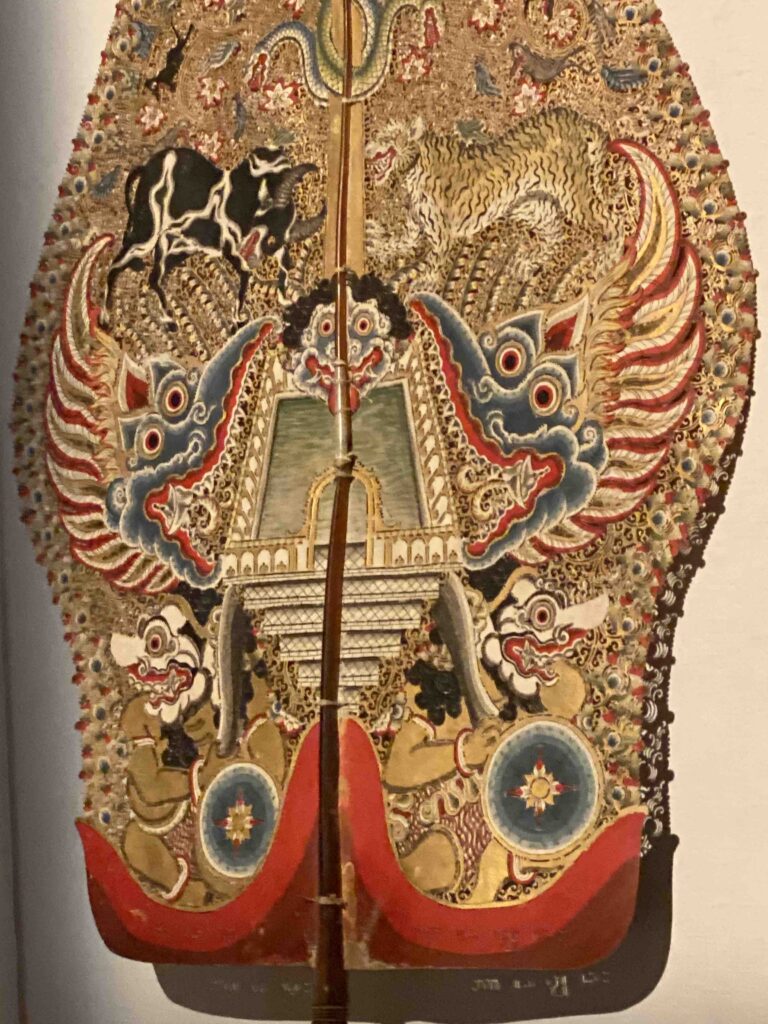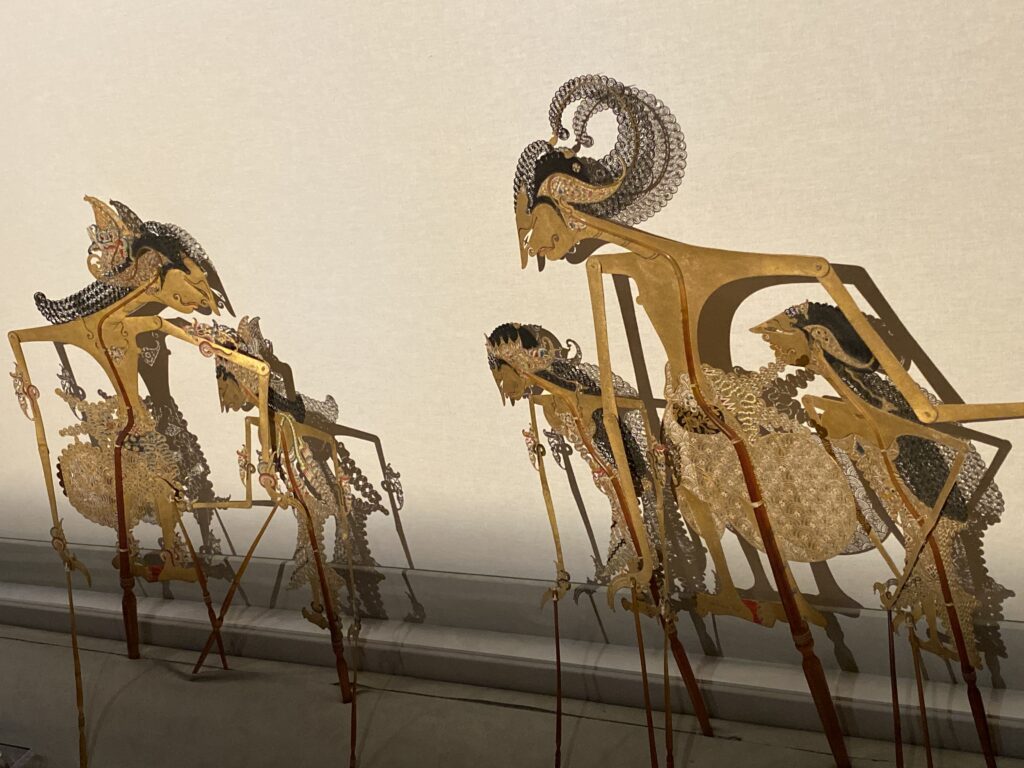Performance and Court in Indonesia. Asian Art Galleries, Yale University Art Gallery, New Haven, CT.

In Indonesia, wayang shadow puppets are presented to the audience in a dizzying swirl of sound and action. The dalang story-teller brings the artfully perforated puppets to life with deft manipulations of shadows that change shape to the shifting rhythms of a clanging gamelan orchestra. As the dalang sings, chants, jokes, and punctuates the dialogue with percussive clacks of a cempala, the characters interact with a rich array of human emotions. The puppets praise, seduce, flatter, betray, mock, and battle each other with gestures that seem to breathe in response to the living flame that casts their shadows on the screen.
The startling beauty of the wayang exhibition at the Yale University Art Gallery comes from the opportunity to contemplate the puppets in silent stillness. The intricate artistry that went into the creation of each painted leather puppet can be appreciated in a way that is not possible during performance. For example, the astonishingly detailed gold-leaf painted depiction of animals, flowers, demons, and sacred symbols embedded in the puppet of the cosmic mountain (kayon) can only be fully appreciated on close inspection. The kaleidoscopic labyrinth of intertwined life-forms serves in performance as an introductory figure linking the mortal world to the realm of divine creation. Seen up close the phantasmagoric imagery makes it easy to understand why the kayon is sometimes described as the source of all stories.
The centerpiece of the exhibition is a scene from the Mahabharata known as Irawan Rabi (Irawan’s Wedding), presented as if it were a stop-action frame from a wayang performance. It is thoughtfully constructed so that a visitor can see the puppets from both sides of a large wayang screen. One side displays the vibrant colors and delicate articulation of each character’s painted form. The other side offers a view of the same character’s shadowy double in perfect silhouette. In an actual performance the spectator would have to choose which side of the screen to watch, but in this simulation of a fragment from the play, time has stopped, and both views of the same instant become accessible.

The action is frozen in the heartbreaking moment when the hero Arjuna informs his son Abimanyu that he cannot marry his beloved Sri Sundari because her father has promised her to someone else. Sundari appears to be collapsing in grief as Abimanyu offers a comforting arm for support. Arjuna is accompanied by his two wives, and the three of them appear to be hanging their heads in acknowledgment of the sad news. Taken together, the five figures could be seen as a family tableau of inconsolable despair: The bowed heads; the gestures of comfort; the lovers reaching towards each other but separated by shadows and fate in the form of sticks that control their movements in the hands of an unseen dalang who knows the story but can’t change how it ends.
The intensity of a visitor’s experience might be heightened if one takes the time to step close enough to see both the painted puppets and their shadows as they are projected on the same side of the screen. The characters and their doubles mirror each other and are inseparable. Life in full color co-exists with its dark side.


This central feature of the exhibit is surrounded by numerous other Indonesian puppets drawn from an extraordinary collection donated to Yale by the Swiss scientist Walter Angst. It consists of over twenty thousand puppets that he collected from a variety of sources. The majority of puppets on display in this particular exhibition were commissioned by Prince Tejakusuma, son of the Sultan Hamengkubuwana VII (r.1877-1921) of Yogyakarta, and crafted by a team of artisans directed by the master artisan Ki Kertiwanda (circa 1937). One of the most evocative wayang is displayed flat inside the open wooden box that dalangs use to store and transport their puppets. It depicts Arjuna in another episode from the Mahabharata known as Arjuna Wiwaha, Arjuna’s meditation. Arjuna sits under a tree attempting to resist the demonic figures who try to disturb his concentration.
Another puppet tradition represented in the exhibition was imported to Indonesia from China. These three-dimensional glove puppets are known as wayang potehi, and are a variation of budaixi, a southern Fujian form of puppet theatre first introduced to Java by Chinese immigrants in the 1700s. The tableau on view inside a colorful puppet booth is from a cycle of stories about the general Si Jin Kwie. The general and his wife are about to sit down for tea, but the most intriguing figure in the scene is the clown servant who seems poised with a teapot to make mischief.
Although the exhibit displays only a small fraction of the Angst collection, it offers visitors an intriguing glimpse into the visual intricacy and dramatic complexity of Indonesian puppetry.
Ron Jenkins
Wesleyan University, Yale Divinity School, Yale Institute of Sacred Music

